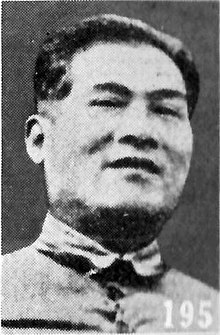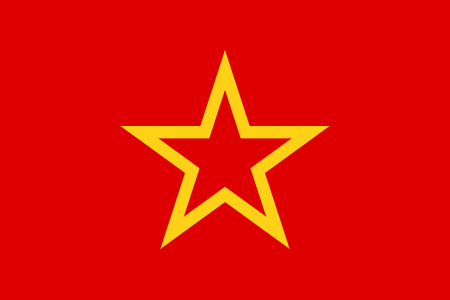* Trước hết xin coi lại đảng kỳ của Hồng Quân Trung Cộng thời kỳ đầu tiên
* Và xác nhận của CS VN đă dùng cờ này trong thời kỳ đầu tiên:
Quốc kỳ Việt Nam là lá cờ đỏ sao vàng...Từ năm 1930, Đảng Cộng sản Việt Nam ra đời vă lănh đạo cách mạng. Thời kỳ đầu, trong các cuộc đấu tranh đă xuất hiện lá cờ đỏ có ngôi sao vàng năm cánh nhưng được lồng trên h́nh búa liềm.
(http://www.lichsuvietnam.vn/home.php...1089&Itemid=69 Quốc kỳ nước cộng ḥa xă hội chủ nhĩa Việt Nam )
____________________ ____________________ ____________________ ____________________ ______________
Tài liệu sử về nội chiến giữa Trung Hoa Dân Quốc và lực lượng Hồng Quân Trung cộng cho thấy thời gian 1928-1930 có cả quân Cộng Sản VN hợp tác cùng với lực lượng Hồng quân Trung cộng tại biên giới Việt Nam và tỉnh Quảng Tây cuả Trung Hoa dưới sự chỉ huy chung cuả cán bộ Hồng Quân Trung Cộng Đặng tiểu B́nh.
Cùng chung một đội quân với Hồng Quân Trung Cộng dưới sự chỉ huy cuả cán bộ Trung Cộng, th́ đương nhiên quân cuả CS VN lúc đó cũng dùng chung một lá cờ nền đỏ có một ngôi sao vàng ' mập ' cuả Hồng quân Trung cộng .
Đây là lư do dễ hiểu cho thấy tại sao lá Đảng Kỳ cuả Hồng Quân Trung cộng thời kỳ đầu tiên có nền đỏ và một ngôi sao vàng năm cánh cạnh cong bầu có lộng h́nh buá liềm cũng được Đảng CS VN dùng trong thời kỳ hoạt động đầu tiên tại VN (1930) và sau này trở thành Quốc Kỳ cuả VC ( không c̣n h́nh buá liềm giữa ngôi sao )
Link: http://www.san.beck.org/21-4-ChinaCivilWar1927-37.html
Title: Nationalist-Communist Civil War 1927-1937 : Nội chiến Quốc-Cộng (Trung Hoa )1927-1937.
By :Sanderson Beck
The CCP Sixth Congress in July 1928 was held in Moscow, and Li Lisan became secretary-general. The number of union members in the Chinese Communist Party (CCP) had fallen drastically, and Zhou Enlai estimated that only three percent of them were proletarians in 1929. Nationalist attacks forced Mao Zedong to move east to the Jiangxi-Fujian border, where he established the Jiangxi Soviet in Ruijin. Mao was removed from command for a few months in 1929 while he recovered from malaria. He called a conference in December in western Fujian and began his “rectification campaigns” to develop party discipline with his report on “The Problem of Correcting Erroneous and Non-Proletarian Ideological Tendencies in the Party.” He wanted to make sure the party was in charge of the military. He criticized officers for beating their men, shooting deserters, maltreating prisoners, and leaving the sick and wounded to die.
The CCP established about fifteen soviets that survived the Nationalist repression, usually in border regions. Deng Xiaoping led a group in southwest Guangxi that cooperated with Vietnamese Communists. Mao and his military commander Zhu De used guerrilla tactics to harass their enemies and arouse the masses. Moscow changed its policy and persuaded Li Lisan that a revolutionary upsurge was imminent. A Central Committee directive issued on December 8 called for expanding the Red Army by incorporating peasant self-defense units and for concentrating rather than dispersing their military forces.
In February 1930 Mao reorganized the Southwest Jiangxi Special Committee with Liu Shaoqi as head, and they ordered the secret execution of four of those who had founded the local party. Over the next few months Liu expelled from the party hundreds of cadres who had been landlords and rich peasants and were suspected of being in the Anti-Bolshevik League (AB-tuan). By October more than a thousand members had been executed. In the army every unit formed a committee to eliminate counter-revolutionaries, and more than 1,300 in the Fourth Army were killed. In the First Front Army 4,400 soldiers confessed to connection with the AB-tuan, and more than 2,000 were shot.
Tạm dịch phần in đậm:
Đảng CS Trung Hoa thiết lập khoảng 15 tổ chức Cộng Sản c̣n sống sót sau sự đàn áp cuả phe Quốc Gia. Luôn luôn nằm tại các vùng biên giới.Đặng tiểu B́nh lănh đạo một nhóm ở tây nam Quảng Tây cùng chung sức với Cộng Sản VN



 Reply With Quote
Reply With Quote









Bookmarks